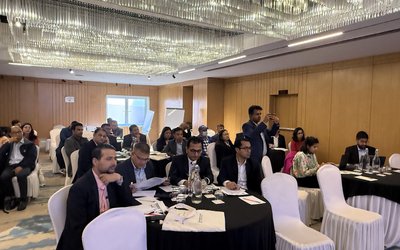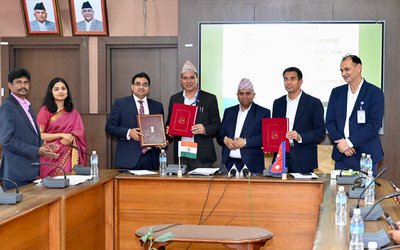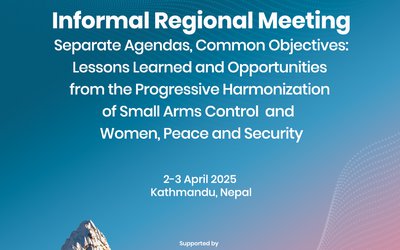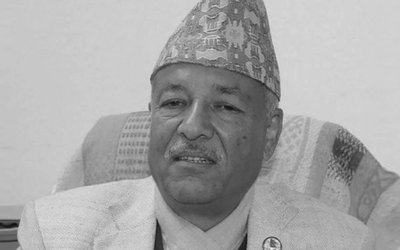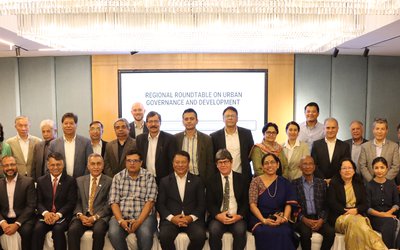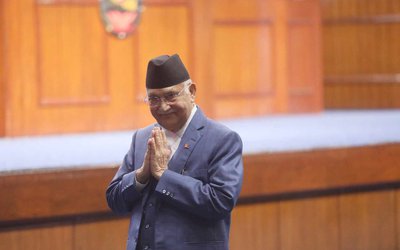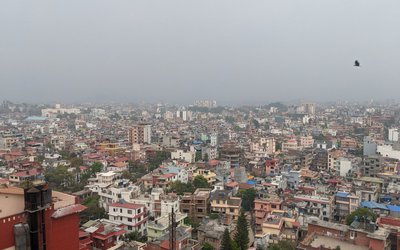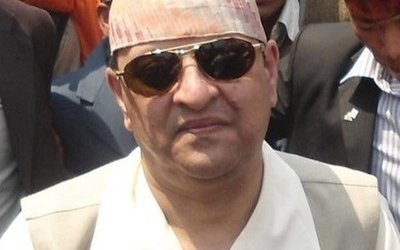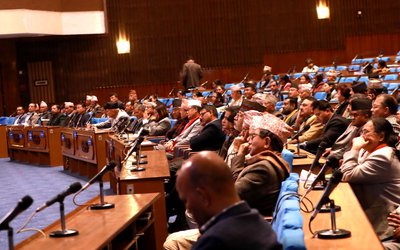
Despite so many commonalities, countries of South Asia have as many differences among themselves. Out of eight members, six countries share land borders with each other. However, they don’t connect each other. With over a billion population, the regional trade is a very negligible, as is bilateral trade among the countries of the region, which is nominal compared to their bilateral trade with countries of other regions. Although South Asian leaders have already gathered seventeen times in the last 30 years, nothing concrete has been achieved to break the barrier in trade, bilateral relations and connectivity. With the piles of challenges, including poverty, climate change, food insecurity and natural disasters, they will need to chart out collective agenda to deal with effectively. As a bigger country in the region, India will determine the prospects of the eighteenth South Asian Association for Regional Cooperation (SAARC)
As Nepal stands at the threshold of hosting the eighteenth SAARC Summit, there is hope as well as despair among the people. Given the experiences of previous seventeen Summits, nothing is there to be jubilant about. However, there is ample reason to hope that a wind of change is seen in the region's horizons in the leadership landscape.
When leaders of eight South Asian Countries meet in Kathmandu, November 26-27, they will have a bulk of important agenda for discussion. From climate change to disaster and poverty to food insecurity, trade restrictions to trade facilitation, connectivity to human movement and security to terrorism, the agenda are so complicated that the leaders have little time to acknowledge them.
As eight South Asian Countries have many things in common and they live in geographically closely connected zones, nothing is impossible if they can work together. But, in reality, they are one of the least integrated regions in the world.
Although the region has a huge market, their inter-country trade is very negligible or less than one percent. With the population of almost one and a half billion, the region has a huge market potential.
Along with the rising economic power, India, the region has another added advantage with the presence of China at the proximity of the region sharing the border with five out of eight countries of the region.
“The eighteenth SAARC Summit is a great opportunity for the countries of the region. They can no longer undermine the potential that exists among them,” said former foreign minister Sujata Koirala.
As the proposed agenda for the summit meeting has already been sent to the capitals of the region, the leaders of the nations will come up with the fresh outlook on them.
"We have already sent the proposed agenda and the countries of the region have already agreed on them. This summit will herald a new era for the region,” said foreign minister Mahendra Bahadur Pandey.
Despite the word of Nepalese foreign minister Pandey, Nepal is yet to receive responses from the major countries regarding their stand. “It is too early now. Diplomacy is not an open game where you can make every word public. Foreign minister Pandey needs to handle the issue more maturely. There is the need to maintain certain secrecy,” said a retired senior foreign ministry official.
China’s presence
Although China shares borders with five South Asian countries, namely, India, Pakistan, Afghanistan, Nepal and Bhutan, it is given just one of nine observer nations. Australia, the US, the European Union, Iran, Japan, South Korea, Mauritius and Myanmar are the other observers, but China's presence will be stronger as it is the largest trade partner of the region worth over 100 billion dollars.
Given the present race of India and China to increase influence, South Asia cannot remain out of their horizon. From Yangon to Australia’s Brisbane to Fiji’s capital Suva, Chinese president Xi Jinping and Indian Prime Minister Narendra Modi are competing to increase their influences. As Nepal is hosting the 18th SAARC Summit, how China, an observer, can move its diplomatic wheel also determines the course of the region.
At a time when relations between China and India have been passing through “competition and cooperation” worldwide, the 18th SARRC Summit will also feel the heat.
Although China has been making frequent efforts to join SAARC as a full member, India has been blocking the thrust by China, arguing that the alliance first needs to clarify its objectives in strengthening ties with new partners.
According to a report published in May on Kolkata-based The Telegraph, Indian foreign ministry has communicated to all other member states of the SAARC —Afghanistan, Bangladesh, Bhutan, the Maldives, Nepal, Pakistan and Sri Lanka — that it is uncomfortable with any expansion of the alliance at present. The Telegraph report cited senior officials in March.
Indian officials said China has increased aggressive lobbying with other member states to join the grouping as a full-fledged member.
Indian officials hold the view that there is absolutely no reason for the expansion of SAARC to include a nation that does not have a direct share in the economy, culture and shared history of South Asia.
As India sees China as a competing power, India holds the view that the introduction of China into the grouping would give smaller nations an option other than India, among major economies, to turn to for economic leadership within SAARC. But it would reduce India’s leverage within the grouping.
SAARC Preparation
Preparation for the SAARC summit is running in high speed. The venue's road construction and other materials and security arrangements have already been made. Security of leaders is handed over to Nepal Army and VVIP cars rented from India.
“We have finalized almost all necessary arrangements for the coming SAARC summit,” said Khag Raj Adhikary, spokesperson of Ministry of Foreign Affairs.
However, out of eight South Asian countries sending representatives in the 18th SAARC, Pakistanis Prime Minister Nawaj Sharif is among two leaders, followed by Indian Prime Minister Narendra Modi, who will use their own VVIP cars during their stay in Nepal.
As the second largest economy and country, Pakistan’s gesture is that it has the capability to bring logistics of its won. Showing solidarity, Indian Prime Minister Narnedra Modi is entering Nepal through Janakpur, Southern religious city. The Indian prime minister will also pay a visit to Lumbini, birthplace of the Buddha and Muktinath of northern Nepal close to the Chinese border. Among the leaders, president of Sri Lanka Mahinda Rajapaksa is also visiting Lumbini.
“These kinds of visits are normal diplomatic practices. It is the obligation of the host nation to fulfill wishes of the visiting high dignitaries to go to such historically and culturally important places,” said Dr. Dinesh Bhattarai, foreign advisor of Prime Minister Sushil Koirala. “The coming SAARC summit is a great opportunity for Nepal to project itself at the regional as well as international level,” said Dr. Bhattarai.
Least connected and less harmonious, the South Asian Association for Regional Cooperation is no more than a merely symbolic organization, having spent almost all its over 20 years of period delivering the tall words and commitments in the paper.
“India needs to show magnanimity for the development of the region. SAARC cannot achieve success without active support from India. There is also the need to accommodate China in the process,” said former foreign minister Narayan Kazi Shrstha.
So far as translating its commitments are concerned, nothing has materialized as desired. Out of its 30 years history, most of the times, India-Pakistan conflict has overshadowed the SAARC. As India and China are economically growing, the coming days will be more challenging in terms of the competiveness and cooperative relations between the two giants.
China has promised much to Nepal. During the recent visit, China has emphasized the need for greater regional connectivity, and to do so it pledged rail networks to the Nepal border. They have also agreed to increase the number of flights between the two nations from 14 per week to 56. India has responded to China’s pledge with promises of its own.
SAARC History
Established in December 1985, South Asian Association for Regional Cooperation (SAARC) was hailed as a major diplomatic breakthrough in South Asia. But SAARC's slow progress and modest achievements over the past decade have evoked different reactions among different people.
Some see SAARC as merely a talking shop, which can provide nothing more than a lip service to the various issues of peace and development in the region. To others, SAARC is not panacea to the region's problems, but its existence has certainly provided an opportunity for the policy makers, administrators, and experts to meet regularly and hold informal dialogue on important bilateral and regional issues.
SAARC has made certain progress as the ratification of SAARC Preferential Trading Arrangement (SAPTA) by all SAARC members in December 1995 and their decision to create a SAARC Free Trade Area (SAFTA) as early as possible have generated guarded optimism about the relevance of SAARC in promoting regional economic cooperation in South Asia.
The idea to establish regional bodies was floated by Bangladesh President Ziaur Rahman during his tenure in 1975-1979. The Bangladeshi proposal was promptly endorsed by Nepal, Sri Lanka, the Maldives and Bhutan.
However, India and Pakistan were skeptical initially. India's main concern was the proposal's reference to the security matters in South Asia. Indian policy makers also held the view that the proposal for a regional organization might provide an opportunity for the small neighbors to regionalize all bilateral issues and to join with each other to gang up against India.
Pakistan had similar feelings as it believed that it might be an Indian strategy to organize the other South Asian countries against Pakistan and ensure a regional market for Indian products, thereby consolidating and further strengthening India's economic dominance in the region.
However, after a series of quiet diplomatic consultations between the South Asian foreign ministers at the U.N. headquarters in New York from August to September 1980, it was agreed that Bangladesh would prepare the draft of a working paper for discussion among the foreign secretaries of the South Asian countries.
Since 1985, SAARC has evolved slowly but continuously both in terms of institutions and programs. However, it is true that most of the programs and achievements of SAARC exist on paper -- be it SAARC Food Security Reserve or Convention on Suppression of Terrorism, it appears to be a failure.
SAARC Secretariat
Although the SAARC has a number of ambitious programs, including poverty, food banks and so on, what it lacks is adequate funds. SAARC suffers from an acute resource crunch. Unless the organization is successful in mobilizing funds and technical knowhow from outside sources, most of its projects cannot be implemented and, thus, its relevance will remain limited.
“I am very hopeful that the eighteenth SAARC Summit will be different than all previous summits of the past. SAARC will move forward from Kathmandu in a much higher speed,” said Arjun Bahadur Thapa, secretary general of SAARC.
Whether one likes it or not, SAARC came into existence primarily as a response to the domestic political and economic needs of the South Asian countries. This is the reason SAARC’s future growth is not likely to be affected adversely by the vagaries of the international system.
Among others, the economic and security concerns and interests of the South Asian states led to take the first initiatives for the establishment of SAARC. Unlike the European Union, the Association of the Southeast Asian Nations, and the Gulf Cooperation Council, external actors or developments did not play any major role in the emergence of SAARC.
Experts argue that SAARC's success is likely to bring enormous economic and security benefits to Bhutan and the Maldives, the two smallest South Asian countries. It will also befit other countries as well. It is, therefore, not surprising that these two countries have shown, and continue to show, a great deal of interest in the growth of regional cooperation in South Asia.
Although South Asia is a big market, it is protectionist in trade. For instance, there are so many restrictions placed by South Asian countries against each other's trade. Despite road access, South Asian countries have to rely on Singapore to make regional trade. Nepal exports its goods to Pakistan, Sri Lanka or Maldives through Singapore. Similar is the case with other countries.
Failing to attract intense international attention in the past, South Asian Association for Regional Cooperation is finally taking a new international shape. At a time when India and China are moving to support Asia-Pacific Island nation, South Asia cannot be the same again.
Taking South Asia as a special region of own influence, how India can stop China, which too shares borders with five countries of the region, remains a major issue. The challenges for SAARC are now how to adjust and balance two big powers of Asia. The eighteenth SAARC summit has many challenges and opportunities as well to make the region prosperous and developed.

Keshab Poudel
Poudel is the editor of New Spotlight Magazine.
- FM Dr. Deuba’s India Visit: Mission Aborted
- Mar 26, 2025
- AMBASSADOR MAEDA TORU: Warm Regards
- Mar 24, 2025
- PRO-MONARCHY MOVEMENT: Rising Dissatisfaction
- Mar 23, 2025
- Dr. PRABIN MANANDHAR: Person With Humility
- Mar 16, 2025
- US SUSPESION OF GRANT: Impact On Nepal
- Mar 10, 2025
